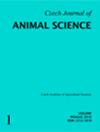蛋鸡日粮中添加马齿苋对生产性能、鸡蛋物理性状、脂肪酸组成和胆固醇含量的影响
IF 1.4
4区 农林科学
Q3 AGRICULTURE, DAIRY & ANIMAL SCIENCE
引用次数: 3
摘要
马齿苋是一种分布广泛的草本植物,尤其富含多不饱和脂肪酸(PUFA)和抗氧化化合物,其特点是健康的omega-6/omega-3比例。本试验旨在评价饲粮中添加马齿苋对蛋鸡生产性能、蛋物性状、脂肪酸组成和胆固醇含量的影响。选取24周龄华伦品系蛋鸡26只,随机分为2组,每组18只和8只,其中一组饲喂商品饲粮(C),另一组饲喂添加20%马齿苋干(PO)的相同对照饲粮。各组饲喂21 d。饲料和水是免费提供的。PO日粮适口性差影响了生产性能的优化,产卵效率显著降低(PO和C的产卵效率分别为0.69和0.88);P < 0.05),影响了蛋的生理性状。从蛋的营养性状来看,饲粮PO显著降低了蛋黄饱和脂肪酸比例(43.0%比44.1%,P < 0.05),显著提高了PUFA含量(19.4%比17.8%,P < 0.001),其中n-6和n-3的omega-6和omega-3比例显著高于C组(分别为16.4%比17.6%,P < 0.001和1.46%比1.80%,P < 0.001)。这导致omega-6/omega-3比值的改善(PO和C分别为10.4 vs 11.3);P < 0.05)。不同饮食处理的蛋黄胆固醇含量无差异。由此可见,一旦克服了适口性问题并满足了母鸡的能量需求,利用马齿苋生产富含ω -3的鸡蛋是可行的。本文章由计算机程序翻译,如有差异,请以英文原文为准。
Effects of dried Portulaca oleracea supplementation to the laying hen diet on productive performance, egg physical traits, fatty acid composition, and cholesterol content
Portulaca oleracea is a widespread herbaceous plant particularly rich in polyunsaturated fatty acids (PUFA), antioxidant compounds and characterised by a healthy omega-6/omega-3 ratio. The focus of this research was to evaluate the effects of Portulaca oleracea supplementation to the diet of laying hens on productive performance, egg physical traits, fatty acid composition and cholesterol content. Twenty-six 24-week-old Warren strain layers were randomly assigned to two different groups of 18 and eight birds, respectively: one group received a commercial diet (C) whereas the other group was given the same control diet supplemented with 20% of dried Portulaca oleracea (PO). Hens were fed for 21 days. Feed and water were provided ad libitum. The poor palatability of the PO diet compromised the optimisation of the productive performance, with a significant reduction of the oviposition efficiency (0.69 vs 0.88 for PO and C, respectively; P < 0.05) and egg physical traits. Considering the egg nutritional traits, dietary PO significantly decreased the yolk proportion of saturated fatty acid (43.0% vs 44.1%, P < 0.05), while it increased the content of PUFA (19.4% vs 17.8%, P < 0.001), and within the latter, both omega-6 and omega-3 proportion significantly increased in comparison with C group (16.4% vs 17.6%, P < 0.001 and 1.46% vs 1.80%, P < 0.001, for n-6 and n-3, respectively). This resulted in an improvement of the omega-6/omega-3 ratio (10.4 vs 11.3 for PO and C, respectively; P < 0.05). Egg yolk cholesterol content did not vary between dietary treatments. It could be concluded that the use of Portulaca oleracea for producing omega-3-enriched eggs is feasible once the problem of palatability has been overcome and the energy requirements of the hens have been covered.
求助全文
通过发布文献求助,成功后即可免费获取论文全文。
去求助
来源期刊

Czech Journal of Animal Science
Agriculture, Dairy & Animal Science-奶制品与动物科学
CiteScore
2.40
自引率
16.70%
发文量
44
审稿时长
5 months
期刊介绍:
Original scientific papers and critical reviews covering all areas of genetics and breeding, physiology, reproduction, nutrition and feeds, technology, ethology and economics of cattle, pig, sheep, goat, poultry, fish and other farm animal management. Papers are published in English.
 求助内容:
求助内容: 应助结果提醒方式:
应助结果提醒方式:


